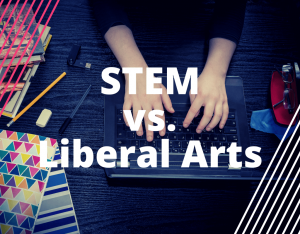There has been a lot of buzz lately in schools and libraries on STEM vs. STEAM. You can even find people on forums arguing which one is better. From days of researching both, it is safe to say that it is a pointless argument.
What’s the difference between STEM vs. STEAM? STEM was created as a concept that integrates and intertwines its disciplines to prepare a future workforce by enhancing real-world problem-solving skills and ingenuity. STEAM adds art to get more people interested in science, technology, engineering, and math and vice versa.
It is important to note that STEAM isn’t necessarily better than STEM because art is added to the mix. It goes deeper than that. In some ways, they are much alike and some ways they are on complete opposite ends of a dispute. Even though this website is all about STEM, measuring them against each other is like putting a kung fu fighter in the octagon with a tai chi practitioner. They have common roots and share some of the same moves, but they are used for different outcomes. So, to know the differences and similarities of STEM vs. STEAM, first, we must learn about their origins and why they were created. From there, we will be able to understand what each is used for so we can ultimately decide which to learn and/or teach our children.
Table of Contents
STEM Beginnings
In an earlier post, I explain how STEM can be traced as far back as the early 1960s. After the United States witnessed Sputnik orbit the Earth in 1957, its goal was to close the gap in the race to space with the Soviet Union. They did this by starting a revolution in education to get students excited about learning science, technology, engineering, and math. This reverberated into the 1970s and 1980s with the excitement of the first space shuttle launch and the first PCs. It boosted even further with the computer and dot-com explosion in the 1990s.
In the late 90s/early 2000’s, the U.S.noticed its competitors, specifically China, quickly advancing in science, technology, and engineering fields. Adding to this were reports pointing out how U.S. student standardized test scores diminishing. This encouraged the U.S. to do something about it much like they did after Sputnik when the future of democracy and freedom through victory in the Cold War was at stake.
In 2001, the director of the National Science Foundation’s education and human resources division decided to put a name to the U.S.’s new Sputnik movement. Judith Ramaley, credited with first coining the term, noted that science and math are essential to understanding the universe, while engineering and technology are used for interacting with the world. She also adds that STEM connects those actions of human elements and understanding into all aspects of education. This means that STEM was created to be integrated into school curriculums to provide real-world experiences.
STEAM Beginnings
Like STEM, some people may say that the concept of STEAM existed before the acronym was created. A common belief is that STEAM was used as early as the 1400s, particularly by Leonardo Da Vinci, whose interest in invention and detailed knowledge of sciences such as anatomy and botany helped him create masterpiece artwork. While this is true, it is a belief based on a specific interpretation of STEAM, which will be explained in the following section.
It is unclear when the STEAM acronym was created, but it is certain that it was created after STEM. The widespread belief among STEAM proponents that the STEM movement has caused less funding for arts programs, leading towards disengaged students.
What does STEAM mean?
STEAM, at first, may seem like a simple concept to grasp, but it all comes down to how you interpret it. There are several interpretations of STEAM that I have found over months of research.
The first one may be the most popular among people who have just learned about STEAM: Science, technology, engineering, art, and math is seen as separate subjects. If a lesson or activity is in one of those disciplines, they believe it’s considered STEAM. This is basically looking at it how schools have taught each subject for decades (separately), but with engineering and technology included. This is an easy way of keeping the integrity of each subject at the sacrifice of them being segmented. There are unfortunately several arts and craft kit manufacturers that use this interpretation to get people to buy their products, by claiming that they are STEAM kits.
The second one is quite new and comes from the concept of STEM: STEAM is seen as an interdisciplinary, integrated, and real-world approach. This is basically what STEM was created to be, but with art included. Problems arise with the differences in what people believe constitutes something as art. Some may say design is art so art is already inherently in STEM through the Engineering Design Process. Others will argue that it’s much deeper than that so it cannot be added to STEM that easily. They might say that the A in STEAM is a watered-down version of art education.
The third interpretation of STEAM falls in between the first two: Art in STEAM is used to get students interested in science, technology, engineering, and math. These interpreters keep the integrity of all subjects while keeping the interdisciplinary nature of STEM. They are usually the ones that believe that art is intended to be appreciated for its beauty or emotional power.
This is where STEAM branches off into two directions based on its intended end goal. If STEAM is used to replace STEM and its goal of preparing a future workforce that will keep up with the momentum of technology, this interpretation creates the divide and spectrum between art and functionality.
Following this direction, it would be tough to come up with a STEAM activity in higher grades (unless coloring or painting the end product, such as an engineered prototype robot or bridge, is involved which may promote graffiti if you think about it). If this interpretation is used to go towards an introductory route to teach the concepts to children or towards more of an artist route for tweens and beyond who are not so much interested in shaping the future for their country, then STEAM activities can be compelling.
Craft challenges for children and photography and videography challenges for adults are excellent in this manner. Using Leonardo Da Vinci as an example, students can be inspired to be knowledgeable in science, technology, engineering, and math to become better artists. This is also a powerful way to get rid of the misconception that you can only be good at math and science but not art at the same time or vice versa.
What Is the Purpose of STEAM?
Now knowing the history behind STEAM and its meaning, we can start to understand its purpose. As mentioned earlier, many STEAM proponents blame the STEM movement for less focus on the arts. Based on its interpretation, a learning activity can be considered STEAM, or it can just be considered STEM.
If the old segmented way of teaching subjects is believed to be working, the purpose of STEAM would simply be as an acronym and nothing more.
If STEAM is believed to be an interdisciplinary and integrated approach to preparing a future workforce with arts inherently in the engineering design process, then using STEAM may hold no purpose even as an acronym.
If the A for art in STEAM is believed to be created to be appreciated for its beauty and emotional power, then the purpose of STEAM is to get students interested in science, technology, engineering, and math through the allure of art or vice versa.
Regardless of its interpretation, STEAM and STEM should be used to get a more diverse number of students interested in its disciplines. Women and minorities have been traditionally underrepresented in the fields of science, technology, engineering, and math. The Obama and Trump administration have both placed high importance on STEM initiatives to bridge this gap.
Related Questions
Is STEAM Becoming STEM?
STEAM and STEM are two different teaching concepts based on their interpretations and desired results. STEAM becomes STEM when the engineering design process is considered art. STEAM does not become STEM when art is seen to elicit emotion primarily.
Why is STEM and STEAM Lumped Together?
STEM and STEAM are lumped together because they cover the same disciplines, but STEAM includes an added A for art. STEAM is generally used to get children interested in science, technology, engineering, and math through the attraction of art activities.
BONUS: STEAM Activity
Galaxy Sugar Crystals
Materials
- mason jars
- measuring cups
- sugar
- small beads or marbles
- red, blue, and yellow food coloring
- pearlized sugar sprinkles
- watercolor
- magnifying glass
Description
Children are naturally attracted to things that sparkle, especially colored things that sparkle. In this easy STEAM activity, you will help children make cool looking galaxy sugar crystals based on a model shown beforehand. You will challenge them to make the same colors by using the engineering design process. The end product will get curious kids interested in the science behind it. Measuring cups will show a real-world example of math. A bonus is that everything will be completely edible!
How To
You will be making galaxy sugar crystals twice: The first time will be the example made beforehand, and the second one will be the one you will be making with the children to try to make it look like the example.
- Measure two cups of water then boil.
- Measure six cups of sugar then add to the boiling water.
- Stir the sugar until dissolved.
- Pour the water into three mason jars.
- Add blue and yellow food coloring to one jar to form green, blue and red food coloring to the second jar to form purple, and red and yellow food coloring to the last jar to create orange.
- Add a small bead or a marble to make the crystals form around it rather than the sides of the jar.
- Let the jar sit for about a week, refrigerate to speed up the process. Refrigerating will make the crystals sticky.
The sugar mix will come out looking like crystals. Use these first three jars to show kids as an example before having them do the activity. Do the first three steps with them then ask if they could match the same colors as your examples by mixing different colors. Have them practice by using watercolor on paper first. Once they are satisfied with their colors, have them do the fifth step mixing the same color of food coloring in each jar. The way they do the final two steps can be up to them. Ask what they think would happen if they put a marble in and refrigerated one, left a marble out of one and let it sit for a week unrefrigerated, and put a marble in the last one and let it sit for a week. After a week, allow them to examine the results by letting them feel the crystals, break them into pieces, and magnify them.
What to Say and Ask
- What two colors make green? How about purple and orange?
- What do you think would happen if we left the marble out of one? How about if we refrigerated one?
- Look at the jars. Did not adding a marble affect the outcome?
- Feel the crystals. What do you notice about the ones that were refrigerated compared to the ones that weren’t?
- Break the crystals and take a look at them with a magnifying glass. Do you notice any patterns? Do the patterns differ between the jars?



